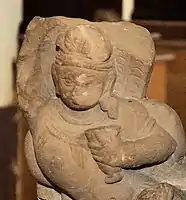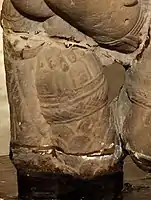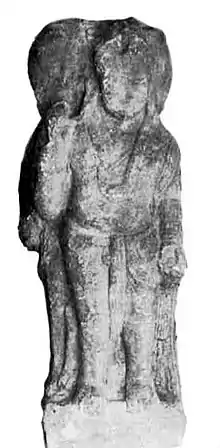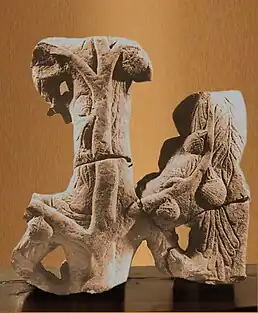Caturvyūha
Caturvyūha or Chatur-vyūha (Sanskrit: चतुर्व्यूह, romanized: Caturvyūha, lit. 'four emanations'), is an ancient Indian religious concept initially focusing on the four earthly emanations (Vyūhas) of the Supreme deity Nārāyaṇa,[1] and later Viṣṇu.[4] The first of these emanations is the hero-god Vāsudeva, with the other emanations being his kinsmen presented as extensions of Vāsudeva himself.[1] From around the 1st century CE, this "Vyuha doctrine" (Vyūhavāda) developed out of the earlier Vīravāda cult of the Vrishni heroes, in which the five heroes Saṃkarṣaṇa, Vāsudeva, Pradyumna, Samba and Aniruddha had remained mostly human in character.[5] Still later, around the 4th century CE, it evolved into the Avatāravāda system of incarnations of Vishnu, in which Vishnu was the primordial being and the Vrishni heroes had become his avatars.[6][4]
The "Four emanations"
Front: Vāsudeva (center) and his kinsmen emanating from him. Vāsudeva is four-armed, and is fittingly in the center with his decorated heavy mace on the side and holding a conch, his elder brother Balarama to his right under a serpent hood, his son Pradyumna to his left (lost), and his grandson Aniruddha on top.[2]
Concept and evolution
The four earthly emanations, or "Vyuhas", are identified as Samkarshana (Balarama-Samkarshana, son of Vasudeva by Devaki),[7][8] Vāsudeva krishna (son of Vasudeva by Devaki),[7][8] Pradyumna (son of Vasudeva Krishna by Rukmini),[7] and Aniruddha (son of Pradyumna).[9][10] They are probably similar the legendary Vrishni heroes of the Mathura region, minus Samba (son of Vasudeva by Jambavati).[7]
Originally, several of these earthly deities, particularly Vāsudeva, seem to have formed one of several major independent cults, together with the cults of Narayana, Shri, and Lakshmi, before they later coalesced to form Vishnuism.[11] The actual cult of Vishnu only developed after these initial cults were established.[11]
The heroes would then have evolved into Vaishnavite deities through a step-by-step process: 1) deification of the Vrishni heroes 2) association with the God Narayana-Vishnu 3) incorporation into the Vyuha concept of successive emanations of the God.[12] Epigraphically, the deified status of Vāsudeva in particular is confirmed by his appearance on the coinage of Agathocles of Bactria (190-180 BCE) and by the devotional character of the Heliodorus pillar inscription (circa 110 BCE).[13] Later, the association with Narayana (Vishnu) is suggested by the Hathibada Ghosundi Inscriptions of the 1st century BCE.[13]
Kushan Caturvyuha (2nd century BCE)
By the 2nd century CE, the "avatara concept was in its infancy", and the depiction of Vishnu with his four emanations (the Chatur-vyūha), consisting in the Vrishni heroes minus Samba, starts to become visible in art at the end of the Kushan period.[4] Starting with the art of Mathura, Vāsudeva (avatar of Vishnu) fittingly appears in the center of the sculptural compositions, with his decorated heavy mace on the side and a conch shell in the hand, his elder brother Balarama to his right under a serpent hood and holding a drinking cup, his son Pradyumna to his left, and his grandson Aniruddha on top.[2]
 Vasudeva with ornate crown and flower necklace, making the Abhaya Mudra
Vasudeva with ornate crown and flower necklace, making the Abhaya Mudra Samkarsana-Balarama under his snake hood holding a cup
Samkarsana-Balarama under his snake hood holding a cup Vasudeva's mace held by one of his supplementary hands
Vasudeva's mace held by one of his supplementary hands
Possible Bhita Caturvyuha (2nd century BCE)

An ancient statue from Bhita near Allahabad (25.308°N 81.794°E), with four figures facing in four directions, now in the Lucknow Museum, has been proposed to represent the Caturvyuha concept,[14] although interpretations vary.[15] It is dated to the 2nd century BCE on stylistic grounds, being quite similar in style to the monumental Yaksha statues.[14][16]
The main figure is bigger than the others, wears a crown and earrings, as well as an ornate necklace and bracelets, and raises his hand in "abahaya mudra", a symbol of deification, and holds jar in the left hand.[14] The figure would be Vāsudeva.[14][1] To the proper right side of the crowned figure appears an unidentifiable face, and below it a seated lion.[14] This part could identified with Samkarsana, combining anthropomorphic and theriomorphic characteristics, and later associated with Narasimha.[14] On the proper left side of the crowned figure also appears an unidentifiable face, and below it a boar on a pedestal, standing on its hind legs, with the front legs joint in the namaskāra gesture of prayer and devotion.[14] This could be Aniruddha, later identified with Varaha.[14] The figure on the reverse is devoid of ornamentation, the hair is parted in the middle and falls loosely, but both arms are broken, making it impossible to identify their attributes.[14] This could be Pradyumna, later associated with Rudra and the fierce-looking Kāpila.[14]
This sculpture of the Caturvyuha shows the Vrishni heroes, but already associates them with their animal form.[14] This seems to prefigure the Vishnu Chaturmurti, in which Vishnu, crowned with a halo, is also flanked by the images of Narasimha and Varaha, with Kāpila in back as seens in the examples from Kashmir.[14]
The general style of the figures is quite similar to that of the early Yakshas, and it has been suggested that their role might have been understood as parallel: just as the Yakshas are considered as emanations of the Supreme deity Brahman, the four Vyuhas are similarly emanations of Narayana.[1]
References
- Srinivasan, Doris (1997). Many Heads, Arms, and Eyes: Origin, Meaning, and Form of Multiplicity in Indian Art. BRILL. pp. 209–210. ISBN 978-90-04-10758-8.
- Paul, Pran Gopal; Paul, Debjani (1989). "Brahmanical Imagery in the Kuṣāṇa Art of Mathurā: Tradition and Innovations". East and West. 39 (1/4): 132–136, for the photograph p.138. ISSN 0012-8376. JSTOR 29756891.
- Paul, Pran Gopal; Paul, Debjani (1989). "Brahmanical Imagery in the Kuṣāṇa Art of Mathurā: Tradition and Innovations". East and West. 39 (1/4): 136 [26]. ISSN 0012-8376. JSTOR 29756891.
- Singh, Upinder (2008). A History of Ancient and Early Medieval India: From the Stone Age to the 12th Century. Pearson Education India. p. 439. ISBN 978-81-317-1677-9.
- Indian History. Allied Publishers. 1988. p. A222. ISBN 978-81-8424-568-4.
- Shaw, Julia (2016). Buddhist Landscapes in Central India: Sanchi Hill and Archaeologies of Religious and Social Change, c. Third Century BC to Fifth Century AD. Routledge. pp. 73–74. ISBN 978-1-315-43263-2.
- Singh, Upinder (2008). A History of Ancient and Early Medieval India: From the Stone Age to the 12th Century. Pearson Education India. pp. 436–438. ISBN 978-81-317-1120-0.
- Joanna Gottfried Williams (1981). Kalādarśana: American Studies in the Art of India. BRILL. pp. 127–131. ISBN 90-04-06498-2.
- Singh, Upinder (2008). A History of Ancient and Early Medieval India: From the Stone Age to the 12th Century. Pearson Education India. pp. 436–440. ISBN 978-81-317-1120-0.
- Williams, Joanna Gottfried (1981). Kalādarśana: American Studies in the Art of India. BRILL. p. 129. ISBN 978-90-04-06498-0.
- Singh, Upinder (2008). A History of Ancient and Early Medieval India: From the Stone Age to the 12th Century. Pearson Education India. p. 436. ISBN 978-81-317-1120-0.
- Srinivasan, Doris (1979). "Early Vaiṣṇava Imagery: Caturvyūha and Variant Forms". Archives of Asian Art. 32: 50. JSTOR 20111096.
- Srinivasan, Doris (1979). "Early Vaiṣṇava Imagery: Caturvyūha and Variant Forms". Archives of Asian Art. 32: 51. ISSN 0066-6637. JSTOR 20111096.
- Srinivasan, Doris (1979). "Early Vaiṣṇava Imagery: Caturvyūha and Variant Forms". Archives of Asian Art. 32: 39–54. ISSN 0066-6637. JSTOR 20111096.
- Harle, James C. (1994). The Art and Architecture of the Indian Subcontinent. Yale University Press. p. 490, note 34. ISBN 978-0-300-06217-5.
- Joshi, N. P. (1972). "Some Unnoticed Finds of Iconographic Interest". East and West. 22 (1/2): 41–49. ISSN 0012-8376. JSTOR 29755743.

